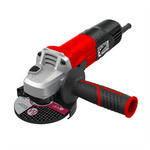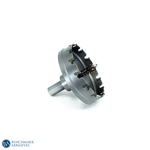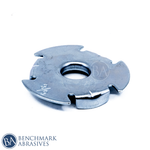
Techniques to Remove Sharp Edges and Burrs from Metal

Metal parts cannot be used right after the cutting process. Many metal pieces, produced by stamping or machining, require further processing before being safely assembled or used. Deburring, also referred to as burr removal, is the process of eliminating burrs and sharp edges. It is a necessary step within the metal-finishing process.
There are many ways to get rid of sharp edges and burrs quickly and affordably from metal parts, including vibratory finishing and barrel tumbling.
Practically every metal cutting process leaves a burr. It's a security hazard, but it can also affect how your parts go together and perform in commission.
What is Burr?
A burr isn't always a pointy edge; it's more sort of a sharp little tooth sticking up from the cut edge. Burrs are the results of plastic deformation, which is what happens when metal is sheared. Some metals deform quite others, then form larger burrs. Generally speaking, it's softer metals like aluminum that make the most critical problems.
Consider a punching operation as an example. The punch comes down and pushes the metal into a hole, the die. When the punch hits the metal, the metal shears through around the edge, but before cracking (which is what happens), it bends into the opening. As there has got to be clearance between punch and die, there's room for a touch burr to make.
Any cutting operation that deforms metal leaves a burr. Punching, cutting, and slitting are all guilty of it. Processes that don't involve deformation generally don't leave burrs. For instance, electrochemical machining and, to an extent, laser cutting are largely burr-free.
Why is Burr-Removal Important?
There is a minimum of three reasons you don't want burrs on the sides of your metal parts:
- Safety. Even the littlest burrs can leave deep lacerations on the hands of the unwary. That's true within the fabrication shop, but also wherever the parts or fabrication find themselves. Nobody wants people to be injured by burrs.
- Fit. Parts might all be move length, but if they need burrs on their edges, likely, they won't go together correctly.
- Function. Perhaps a fabrication did go together correctly, but if there are burrs thereon, it will not function properly or could fail prematurely. Eventually, the burrs will break off and will get drawn into a pump or fan. Alternatively, a hose or cable might rub against burrs on a foothold. Any vibration will have those burrs acting like tiny saw teeth, quickly cutting through the sheathing.
Techniques to Remove Burrs
The deburring and sharp edge removal currently involves 80 different processes in metal manufacturing.
Some of these methods require more manual labor, while others are automated. There's also a systematic difference. You'll apply thermal or mechanical methods to get an excellent result.
Here are some standard deburring methods to help you identify the most uncomplicated deburring process for your metal parts.
1. Manual Deburring
It is the earliest and most basic technique for getting rid of burr. It requires a skillful artisan to ensure the simplest results. Therefore, it's a way that takes tons of your time and energy.
It is a time-consuming technique and is mostly utilized in small shops with a coffee production rate. Cleaning large batches isn't cost-effective, but having the specified skills within the workshop may be handy.
Standard tools used to apply this method include deburring knives, files, sandpapers, and other polishing tools.
2. Punch Deburring
This method utilizes a punching machine for burr removal. Different kinds of dies, such as rough blanking, fine blanking, and sizing dies, are needed for the punch mold work.
3. Hole Deburring
This method is employed when deburring is required on the inner part of a hole. There is a spread of tools to use this method available within the current market, but they typically have an equivalent configuration.
A cutter is spring-loaded and mounted on a spindle. This tool is positioned to undergo the opening smoothly and comes out by touching the surface with the sting that cuts the burr without causing any scratches or damages. A number of the cutting tools have a tapered end that permits making a chamfer at the front of the opening when entering.
4. Brushing
Considering the name of the tactic, it's easy to deduce that, in this method, the burr is removed by "cleaning" the surface with a particular sort of brush.
The method works similarly, thanks to manually deburring with sandpaper and similar tools. The deburring brushes are usually made from abrasive materials with a selected grit number.
The main difference is that most of those brushes are designed to mount on machine tools, making the method more efficient and increasing the likelihood of automating this manufacturing step.
5. Electrochemical Deburring
Small metal parts with burrs that are inaccessible to conventional deburring techniques are typically subjected to this technique. It's the reverse operation of the plating. Rather than adding material, electrochemical deburring eliminates it.
This process uses a tool with a shape almost like the sting being deburred. The tool, in this case, an electrode, works alongside an electrical current and a solution of common salt or soda niter as an electrolyte.
6. Tumbling
Another way to supply an excellent finish for your metal parts is by using a vibrating or centrifugal container. The barrel contains a mix of abrasives and liquids. These begin to move and rub against the metal components as a result of the vibration.
It results in eliminating burrs without scratching the surface besides removing burrs, deburring by tumbling leaves and an excellent overall surface finish to the parts.
7. Grinding and Rolling
If you're trying to find a high-quality finish without an excessive amount of hassle, mechanical deburring by grinding or rolling could also be for you. While somewhat similar to manual deburring, it's much faster and thus cost-efficient.
8. Thermal Deburring
Also called the Thermal Energy Method (TEM), it's mainly used to treat many pieces and everyone on their surfaces at the same time. The burr is eliminated by burning the fabric during a controlled combustion chamber. A mix of oxygen and gas is usually used because of the energy source.
The most crucial step is determining the proper proportion of oxygen and fuel that has to be used to generate enough heat to get rid of the burr without hurting the piece.
CHOOSING THE RIGHT DEBURRING TECHNIQUE
Choosing the right deburring technique is based on the following factors:
-
Metal Type: The type of metal is a crucial factor while deburring the metal. As there are different types of metal and they each have different properties affecting the way they can be burr. For example, there are some brittle metals compared to other types of metals that require more gentle deburring techniques.
-
Size and shape: The size and shape of the part will also play a crucial role in selecting the right deburring method. For example, small parts require hand tools to deburr, whereas large parts can be deburred by using a power machine.
-
Desired finish: Selecting the right deburring technique also depends on the desired outcome. For example, if you want a smooth finish, you may require a fine-grit abrasive, and if you want a more textured finish, then use a coarser abrasive.
-
Production volume: This also affects the decision of choosing the right deburring technique. If you want to deburr a large number of parts, a machine can be used to deburr, and if you want to deburr a small part, hand tools are required.
Conclusion
The most cost-effective way of working is to minimize the number of processes. As a result, we advise using a manufacturer who can provide burr-free, clean parts whenever feasible. But with specific materials and thicknesses, it's just impossible. Of course, the burr is merely on one side of the fabric.



































































